Sony SNC-XM637, SNC-XM636, SNC-VM642R, SNC-VM641, SNC-XM631 User Manual
...
A-EN2-100-18 (1)
Network Camera
User’s Guide
Before operating the unit, please read this manual thoroughly and retain it for future reference.
Software Version 2.8
SNC-VB635/VB630/VB600/VB600B/VB632D/VB640/VB642D SNC-VM630/VM600/VM600B/VM631/VM601/VM601B/
VM632R/VM602R/VM641/VM642R SNC-EB630/EB630B/EB600/EB600B/EB632R/EB602R/
EB640/EB642R SNC-EM630/EM600/EM631/EM601/EM632R/EM632RC/
EM602R/EM602RC/EM641/EM642R SNC-XM637/XM636/XM632/XM631 SNC-CX600W/CX600
© 2012 Sony Corporation

Table of Contents |
|
Overview |
|
Features .................................................................. |
4 |
How to Use This User’s Guide .............................. |
5 |
System Requirements ............................................ |
5 |
Function Chart ...................................................... |
6 |
Accessing the Camera Using the Web |
|
Browser ................................................................... |
8 |
Basic Configuration by the Administrator ....... |
10 |
Precautions for Preventing Access to the Camera |
|
by an Unintended Third Party ........................... |
11 |
How to set up ................................................... |
11 |
Operating the Camera |
|
Administrator and User ...................................... |
12 |
Logging in to System ........................................... |
13 |
Logging in as a user ......................................... |
13 |
About Viewers .................................................. |
13 |
Configuration of Live Viewer ............................. |
14 |
Main menu ....................................................... |
14 |
Control panel section ....................................... |
14 |
Monitor image .................................................. |
16 |
Plug-in free viewer ........................................... |
16 |
Using e-Varifocal and Solid PTZ functions ..... |
16 |
Controlling via the control panel (Operation |
|
common to Area zoom mode and Vector |
|
dragging mode) .............................................. |
17 |
Panning and tilting by clicking the monitor image |
|
(Area zoom mode only) ................................. |
17 |
Panning, tilting and zooming by specifying the |
|
area (Area zoom mode only) .......................... |
18 |
Panning and tilting by dragging the screen (Vector |
|
dragging mode only) ...................................... |
18 |
Using pan/tilt/zoom operations with the displayed |
|
control bar (PTZ Control bar only) ................ |
18 |
Switching Transmission Mode ........................... |
19 |
Playback viewer ................................................... |
20 |
Control panel section ....................................... |
20 |
Monitor image .................................................. |
22 |
Administrating the Camera |
|
Basic Operations of the Administrator |
|
Menu ..................................................................... |
23 |
How to set up the Administrator menu ............ |
23 |
Configuration of the Administrator menu ........ |
23 |
Configuring the System — System Menu ......... |
24 |
Information Tab ................................................ |
24 |
Date & time Tab ................................................ |
24 |
Installation Tab ................................................. |
25 |
Initialize Tab ..................................................... |
26 |
System log Tab ................................................. |
27 |
Access log Tab .................................................. |
27 |
Setting the Camera Image and Audio |
|
— Video / Audio Menu Setting the Camera Image |
|
— Video Menu ...................................................... |
28 |
Picture Tab ........................................................ |
28 |
Focus Tab — Adjusting the Focus .................... |
30 |
Focus / Zoom Tab — Adjusting the |
|
focus/zoom ...................................................... |
31 |
Video codec Tab ............................................... |
31 |
Audio Tab ......................................................... |
33 |
Superimpose Tab .............................................. |
33 |
Day/Night Tab .................................................. |
34 |
Privacy masking Tab ......................................... |
35 |
Streaming Tab ................................................... |
36 |
Configuring the Network — Network Menu ..... |
38 |
Network Tab ..................................................... |
38 |
Wi-Fi Tab .......................................................... |
40 |
Wi-Fi network connection check ...................... |
40 |
Manual setting of a Wi-Fi network ................... |
41 |
WPS settings ..................................................... |
41 |
Connection status .............................................. |
42 |
QoS Tab ............................................................ |
43 |
UPnP Tab .......................................................... |
44 |
Setting the Security — Security Menu ............... |
44 |
User Tab ............................................................ |
44 |
Access limit Tab ............................................... |
45 |
SSL Tab ............................................................ |
46 |
How to install the CA certificate ...................... |
49 |
To remove an installed CA certificate .............. |
50 |
802.1X Tab ....................................................... |
50 |
System configuration of 802.1X network ........ |
51 |
Referer check tab .............................................. |
52 |
Setting the PTZ control — PTZ control |
|
Menu ..................................................................... |
53 |
View angle Tab ................................................. |
53 |
Serial Tab .......................................................... |
54 |
Setting the Sensor input/Camera tampering |
|
detection/Motion detection — Action input |
|
Menu ..................................................................... |
54 |
Event condition Tab .......................................... |
55 |
Sensor input Tab — Set the sensor input 1/2 .... |
55 |
Camera tampering detection Tab — Set the |
|
camera tampering detection ............................ |
56 |
Motion detection Tab — Set the motion/VMF |
|
detection .......................................................... |
56 |
What is VMF .................................................... |
56 |
Setting items for motion detection .................... |
57 |
VMF settings .................................................... |
58 |
Face detection Tab — Set the face detection .... |
61 |
2 Table of Contents

Network disconnection Tab — Monitoring the |
|
connection of a specified IP address .............. |
62 |
Setting the Action output — Action output |
|
Menu ..................................................................... |
63 |
Execution Condition Tab .................................. |
63 |
Mail Transfer Tab — Setting the e-Mail (SMTP) |
|
Function .......................................................... |
63 |
Alarm output Tab — Setting the Alarm |
|
output .............................................................. |
66 |
Edge Storage Tab — Setting the Edge Storage |
|
movie and still image function ....................... |
66 |
Voice alert Tab .................................................. |
68 |
HTTP alarm notification Tab ........................... |
69 |
FTP still image sending Tab ............................. |
69 |
White LED tab ................................................. |
71 |
Setting the Schedule — Schedule Menu ............ |
72 |
Schedule Tab .................................................... |
72 |
Others |
|
Glossary ................................................................ |
74 |
Index ..................................................................... |
76 |
Table of Contents |
3 |
|
|

Overview
Overview
Features
•High-quality Full HD (1080P) real-time monitoring, up to 60 fps. (SNC-VB635/VB630/VB632D/VB640/ VB642D/VM630/VM631/VM632R/VM641/ VM642R/EB640/EB642R/EM641/EM642R)
•High-quality Full HD (1080P) real-time monitoring, up to 30 fps. (SNC-XM637/XM636/XM632/XM631)
•High-quality SXGA (1280 × 1024) live images from camera can be monitored at a maximum frame rate of 60 fps. (SNC-VB635/VB630/VB600/VB632D/ VM630/VM600/VM631/VM601/VM632R/ VM602R)
•High-quality HD (720P) real-time monitoring, up to 30 fps. (SNC-CX600W/CX600)
•Exmor CMOS sensor enables high-quality images for streaming.
•Wide dynamic range (View-DR) and Visibility Enhancer enable clearer images for streaming in the high contrast environment.
•NR (XDNR) enables clearer images for streaming in the low lightness environment.
•Two video compression modes (video codecs) JPEG/ H.264 are supported.
•The maximum triple codec mode is available.
•Easy Focus enables easier focus adjustment when it is installed. (Except SNC-EB630B/EB600B/XM637/ XM636/XM632/XM631/CX600W/CX600)
•“Edge Storage” for recording of video or audio signal based on alarm detection (such as network block), and same protocol real-time image streaming. (SNCVB635/VB630/VB600/VB600B/VB632D/VB640/ VB642D/VM630/VM600/VM600B/VM631/ VM601/VM632R/VM602R/VM641/VM642R/ EB640/EB642R/EM641/EM642R/XM637/XM636/ XM632/XM631)
•Motion detection, passive infrared motion sensor (SNC-CX600W/CX600) and camera tampering detection functions.
•At night, the color mode and intimidation function can be selected by synchronizing the white LED with the motion detection function. (SNC-VB632D/VB642D)
•Up to 20 users (SNC-CX600W/CX600: five users) can view images from one camera at the same time.
•Date/time can be superimposed on the image.
•PoE (Power over Ethernet) compliant. (except SNCCX600W)
•The recorded movie in the memory card can be played, saved, or deleted by using the browser. (SNCVB635/VB630/VB600/VB600B/VB632D/VB640/ VB642D/VM630/VM600/VM600B/VM631/ VM601/VM601B/VM632R/VM602R/VM641/ VM642R/EB640/EB642R/EM641/EM642R/XM637/ XM636/XM632/XM631/CX600W/CX600)
•The camera image can be sent by using Wi-Fi. (SNCCX600W)
NOTICE TO USERS
© 2012 Sony Corporation. All rights reserved. This manual or the software described herein, in whole or in part, may not be reproduced, translated or reduced to any machine readable form without prior written approval from Sony Corporation.
SONY CORPORATION PROVIDES NO WARRANTY WITH REGARD TO THIS MANUAL, THE SOFTWARE OR OTHER INFORMATION CONTAINED HEREIN AND HEREBY EXPRESSLY DISCLAIMS ANY IMPLIED WARRANTIES OF MERCHANTABILITY OR FITNESS FOR ANY PARTICULAR PURPOSE WITH REGARD TO THIS MANUAL, THE SOFTWARE OR SUCH OTHER INFORMATION. IN NO EVENT SHALL SONY CORPORATION BE LIABLE FOR ANY INCIDENTAL, CONSEQUENTIAL OR SPECIAL DAMAGES, WHETHER BASED ON TORT, CONTRACT, OR OTHERWISE, ARISING OUT OF OR IN CONNECTION WITH THIS MANUAL, THE SOFTWARE OR OTHER INFORMATION CONTAINED HEREIN OR THE USE THEREOF.
Sony Corporation reserves the right to make any modification to this manual or the information contained herein at any time without notice.
The software described herein may also be governed by the terms of a separate user license agreement.
• is trademark of Sony Corporation.
is trademark of Sony Corporation.
•“Exmor” and  are trademarks of Sony Corporation.
are trademarks of Sony Corporation.
•“Exmor R” and 


 are trademarks of Sony Corporation.
are trademarks of Sony Corporation.
•Microsoft, Windows, Internet Explorer and Microsoft DirectX are registered trademarks of Microsoft Corporation in the United States and/or other countries.
•Java Script is a trademark of Sun Microsystems, Inc. in the United States and other countries.
•Intel Core is a registered trademark of Intel Corporation or its subsidiaries in the United States and other countries.
•Adobe, Adobe Reader and Adobe Flash are trademarks of Adobe Systems Incorporated in the United States and/or other countries.
•SD and microSD are trademarks of SD-3C and LLC.
All other company and product names are trademarks or registered trademarks of the respective companies or their respective makers.
4 Features

How to Use This User’s Guide
This User’s Guide explains how to operate the Network Camera from a computer.
The User’s Guide is designed to be read on the computer display.
This section gives tips on making the most of the User’s Guide. Read it before you operate the camera.
Jumping to a related page
When you read the User’s Guide on the computer display, you can click on a sentence to jump to a related page.
Software display examples
Note that the displays shown in the User’s Guide are explanatory examples. Some displays may be different from the ones that appear in actual use.
The illustrations of the camera and menu display in the User’s Guide show the SNC-VB600 as an example.
Printing the User’s Guide
Depending on your system, certain displays or illustrations in the User’s Guide, when printed out, may differ from those that appear on your screen.
Installation Manual (printed matter)
The supplied Installation Manual describes the names and functions of parts and controls of the Network Camera, connection examples, and how to set up the camera. Be sure to read the Installation Manual before hand.
Model names
The models below are omitted in this document as their functions are equal to the relevant models.
•SNC-EM632RC is described as SNC-EM632R on the following pages.
•SNC-EM602RC is described as SNC-EM602R on the following pages.
System Requirements
The following computer environment is necessary for the computer to display images and the controls of the camera.
(March 2017)
Common
OS
Microsoft Windows 7 (32-bit version, 64-bit version), Windows 8.1 Pro (32-bit version, 64-bit version), Windows 10 Pro (32-bit version, 64-bit version)*
Authorized editions:
Windows 7: Ultimate, Professional Windows 8.1: Pro
Windows 10: Pro
Microsoft DirectX 9.0c or higher
Web Browser
Windows Internet Explorer Ver.11.0**
Firefox Ver.50.1
Google Chrome Ver.55.0
CPU
Intel Core i7, 2.8 GHz or higher
Intel Core2 Duo, 2.13 GHz or higher (SNC-CX600W/ CX600)
Memory
2 GB or more
Display
1600 × 1200 pixels or higher
*If you are on Windows 10, turn off tablet mode.
**If you are on Windows 8.1, use the Internet Explorer desktop user interface (desktop UI) edition.
Overview
How to Use This User’s Guide / System Requirements |
5 |
|
|

Function Chart
Overview
|
Maximum |
High |
Sensor |
Alarm |
Edge |
Audio |
IR |
Serial |
|
|
framerate |
input |
output |
Storage |
(page 33) |
Illuminator |
control I/F |
||
Model name |
image size |
||||||||
mode |
(page 54) |
(page 66) |
(page 66) |
|
(page 34) |
(page 54) |
|||
|
(page 32)* |
|
|||||||
|
(page 31)** |
|
|
|
|
|
|
||
|
|
|
|
|
|
|
|
||
|
|
|
|
|
|
|
|
|
|
SNC-VB635 |
Full HD |
z |
2 |
2 |
z |
z |
– |
z |
|
|
|
|
|
|
|
|
|
|
|
SNC-VB630 |
Full HD |
z |
2 |
2 |
z |
z |
– |
– |
|
|
|
|
|
|
|
|
|
|
|
SNC-VB600 |
HD |
z |
2 |
2 |
z |
z |
– |
– |
|
|
|
|
|
|
|
|
|
|
|
SNC-VB600B |
HD |
– |
2 |
2 |
z |
z |
– |
– |
|
|
|
|
|
|
|
|
|
|
|
SNC-VB632D |
Full HD |
z |
2 |
2 |
z |
z |
z |
– |
|
|
|
|
|
|
|
|
|
|
|
SNC-VB640 |
Full HD |
z |
2 |
2 |
z |
z |
– |
– |
|
|
|
|
|
|
|
|
|
|
|
SNC-VB642D |
Full HD |
z |
2 |
2 |
z |
z |
z |
– |
|
|
|
|
|
|
|
|
|
|
|
SNC-VM630 |
Full HD |
z |
2 |
2 |
z |
z |
– |
– |
|
|
|
|
|
|
|
|
|
|
|
SNC-VM600 |
HD |
z |
2 |
2 |
z |
z |
– |
– |
|
|
|
|
|
|
|
|
|
|
|
SNC-VM600B |
HD |
– |
2 |
2 |
z |
z |
– |
– |
|
|
|
|
|
|
|
|
|
|
|
SNC-VM631 |
Full HD |
z |
2 |
2 |
z |
z |
– |
– |
|
|
|
|
|
|
|
|
|
|
|
SNC-VM601 |
HD |
z |
2 |
2 |
z |
z |
– |
– |
|
|
|
|
|
|
|
|
|
|
|
SNC-VM601B |
HD |
– |
2 |
2 |
z |
z |
– |
– |
|
|
|
|
|
|
|
|
|
|
|
SNC-VM632R |
Full HD |
z |
2 |
2 |
z |
z |
z |
– |
|
|
|
|
|
|
|
|
|
|
|
SNC-VM602R |
HD |
z |
2 |
2 |
z |
z |
z |
– |
|
|
|
|
|
|
|
|
|
|
|
SNC-VM641 |
Full HD |
z |
2 |
2 |
z |
z |
– |
– |
|
|
|
|
|
|
|
|
|
|
|
SNC-VM642R |
Full HD |
z |
2 |
2 |
z |
z |
z |
– |
|
|
|
|
|
|
|
|
|
|
|
SNC-EB630 |
Full HD |
– |
– |
– |
– |
– |
– |
– |
|
|
|
|
|
|
|
|
|
|
|
SNC-EB630B |
Full HD |
– |
– |
– |
– |
– |
– |
– |
|
|
|
|
|
|
|
|
|
|
|
SNC-EB600 |
HD |
– |
– |
– |
– |
– |
– |
– |
|
|
|
|
|
|
|
|
|
|
|
SNC-EB600B |
HD |
– |
– |
– |
– |
– |
– |
– |
|
|
|
|
|
|
|
|
|
|
|
SNC-EB632R |
Full HD |
– |
– |
– |
– |
– |
z |
– |
|
|
|
|
|
|
|
|
|
|
|
SNC-EB602R |
HD |
– |
– |
– |
– |
– |
z |
– |
|
|
|
|
|
|
|
|
|
|
|
SNC-EB640 |
Full HD |
z |
– |
– |
z |
z |
– |
– |
|
|
|
|
|
|
|
|
|
|
|
SNC-EB642R |
Full HD |
z |
– |
– |
z |
z |
z |
– |
|
|
|
|
|
|
|
|
|
|
|
SNC-EM630 |
Full HD |
– |
– |
– |
– |
– |
– |
– |
|
|
|
|
|
|
|
|
|
|
|
SNC-EM600 |
HD |
– |
– |
– |
– |
– |
– |
– |
|
|
|
|
|
|
|
|
|
|
|
SNC-EM631 |
Full HD |
– |
– |
– |
– |
– |
– |
– |
|
|
|
|
|
|
|
|
|
|
|
SNC-EM601 |
HD |
– |
– |
– |
– |
– |
– |
– |
|
|
|
|
|
|
|
|
|
|
|
SNC-EM632R |
Full HD |
– |
– |
– |
– |
– |
z |
– |
|
|
|
|
|
|
|
|
|
|
|
SNC-EM602R |
HD |
– |
– |
– |
– |
– |
z |
– |
|
|
|
|
|
|
|
|
|
|
|
SNC-EM641 |
Full HD |
z |
– |
– |
z |
z |
– |
– |
|
|
|
|
|
|
|
|
|
|
|
SNC-EM642R |
Full HD |
z |
– |
– |
z |
z |
z |
– |
|
|
|
|
|
|
|
|
|
|
|
SNC-XM637 |
Full HD |
– |
– |
– |
z |
z |
– |
– |
|
(only mic) |
|||||||||
|
|
|
|
|
|
|
|
||
|
|
|
|
|
|
|
|
|
|
SNC-XM636 |
Full HD |
– |
– |
– |
z |
z |
– |
– |
|
(only mic) |
|||||||||
|
|
|
|
|
|
|
|
||
|
|
|
|
|
|
|
|
|
|
SNC-XM632 |
Full HD |
– |
– |
– |
z |
z |
– |
– |
|
(only mic) |
|||||||||
|
|
|
|
|
|
|
|
||
|
|
|
|
|
|
|
|
|
|
SNC-XM631 |
Full HD |
– |
1 |
1 |
z |
– |
– |
– |
|
|
|
|
|
|
|
|
|
|
|
SNC-CX600W |
HD |
– |
– |
– |
z |
z |
– |
– |
|
|
|
|
|
|
|
|
|
|
6 Function Chart

|
Maximum |
High |
Sensor |
Alarm |
Edge |
Audio |
IR |
Serial |
|
|
framerate |
input |
output |
Storage |
(page 33) |
Illuminator |
control I/F |
||
Model name |
image size |
||||||||
mode |
(page 54) |
(page 66) |
(page 66) |
|
(page 34) |
(page 54) |
|||
|
(page 32)* |
|
|||||||
|
(page 31)** |
|
|
|
|
|
|
||
|
|
|
|
|
|
|
|
||
|
|
|
|
|
|
|
|
|
|
SNC-CX600 |
HD |
– |
– |
– |
z |
z |
– |
– |
|
|
|
|
|
|
|
|
|
|
z Usable function
– Not usable function
*Maximum image size; HD: 1280 × 1024, Full HD: 1920 × 1080, SNC-CX600W/CX600 HD: 1280 × 720
**High framerate mode: Monitoring maximum 60 frames
Overview
Function Chart |
7 |
|
|
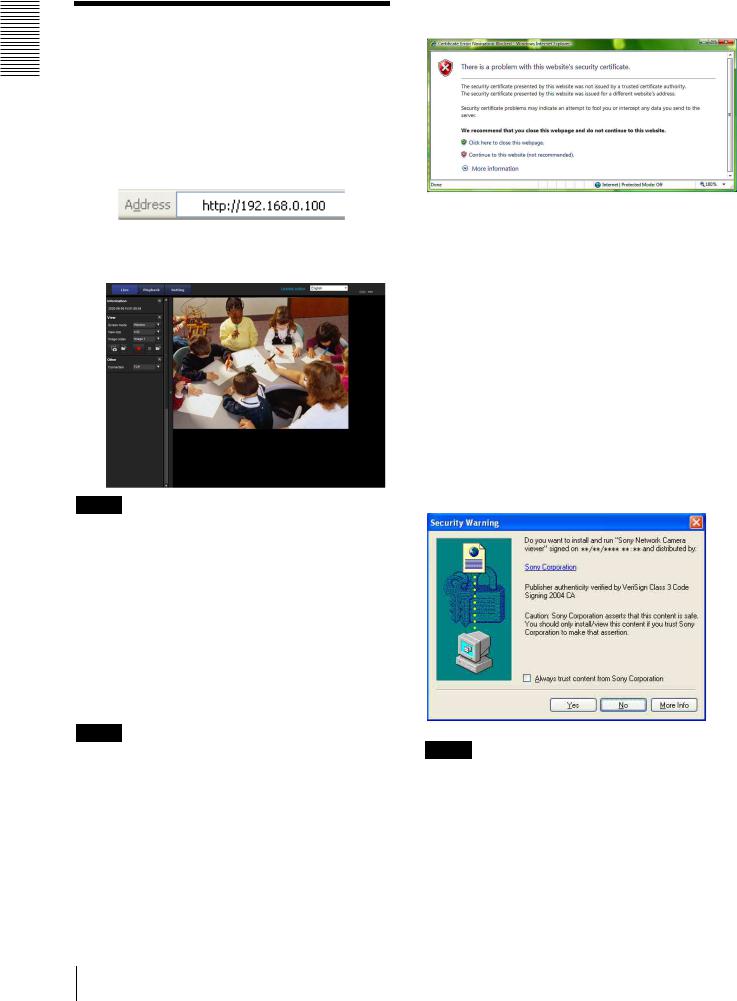
Overview
Accessing the Camera
Using the Web Browser
After the IP address has been assigned to the camera, check that you can actually access the camera using the Web browser installed on your computer.
1 Start the Web browser on the computer and type the IP address of the camera in the URL address bar.
The live viewer window is displayed.
Display sample
Note
•The maximum number of users on the network who can see a viewer at the same time is 20 users (SNC-CX600W/CX600: five users). However, if the transmission function of the camera is overloaded, access to the camera may not be possible, even if there are fewer than the maximum number of users.
•If monitoring with sound, the maximum number of users is 10.
•When using a Wi-Fi network, it may take longer for the image to be transmitted. (SNC-CX600W)
Using the SSL function
Note
The model on sale in China does not support the SSL function.
When Internet Explorer is used
When you enter the camera IP address, “Certificate Error” may appear according to the status of the certificate set on the camera. In this case, click Continue to this website (not recommended). to continue.
The live viewer window appears (in SSL communication).
When “Allow HTTP connection for some clients” (page 46) is checked
To use HTTP and SSL connections separately to access, enter the following in the address box of the browser.
For HTTP connection
http://192.168.0.100/index.html?lang=en
For SSL connection https://192.168.0.100/index.html?lang=en
When the live viewer of the camera is displayed for the first time
“Security Warning” is displayed. When you click Yes, ActiveX control is installed and the live viewer is displayed.
Notes
•If Automatic configuration is enabled in the Local Area Network (LAN) settings of Internet Explorer, the image may not be displayed. In that case, disable
Automatic configuration and set the proxy server manually. For the setting of the proxy server, consult your network administrator.
•When you install ActiveX Control, you should be logged in to the computer as Administrator.
8 Accessing the Camera Using the Web Browser

Tips
•The software is optimized for Internet Explorer using medium font.
•In case a part of the image cannot fit the display, configure the display setting (magnification percentage) to 100%.
If you use a display with high pixel density, the magnification percentage may be changed automatically.
To display the viewer correctly
To operate the viewer correctly, set the security level of Internet Explorer to Medium or lower, as follows:
1 Select Tools from the menu bar for Internet Explorer, then select Internet Options and click the Security tab.
2 Click the Internet icon (when using the camera via the Internet), or Local intranet icon (when using the camera via a local network).
3 Set the slider to Medium or lower. (If the slider is not displayed, click Default Level.)
When using antivirus software, etc., on the computer
•When you use antivirus software, security software, personal firewall or pop-up blocker on your computer, the camera performance may be reduced, for example, the frame rate for displaying the image may be lower.
•The Web page displayed when you log in to the camera uses JavaScript. The display of the Web page may be affected if you use antivirus software or other software described above on your computer.
Overview
Accessing the Camera Using the Web Browser 9

Overview
Basic Configuration by the Administrator
You can monitor the camera image by logging in with the initial conditions set for this network camera. You can also set various functions according to the installing position, network conditions or purpose of the camera. We recommend you configure the following items before monitoring images from the camera.
Setting contents |
Setting menu |
|
|
Set the format of the image sent from the camera. |
Video codec Tab (page 31) |
|
|
Select the White balance mode according to the installation position. |
White balance (page 29) |
|
|
Select the brightness of the image sent from the camera. |
Exposure (page 29) |
|
Brightness (page 30) |
|
|
Select the quality of the image sent from the camera. |
Video codec Tab (page 31) |
|
|
Select the view size of the image. |
View size (page 14) |
|
|
Select whether the audio from the external input is sent or not. |
Audio Tab (page 33) |
|
|
Synchronize the date and time of the camera with those of the computer. |
Date & time Tab (page 24) |
|
|
Make the setting for sending the monitor image attached to an e-mail. |
Mail Transfer Tab (page 63) |
|
|
Set the user access right for the camera. |
User Tab (page 44) |
|
|
Use Wi-Fi to make the setting for connecting the camera (SNC-CX600W) |
Wi-Fi Tab (page 40) |
|
|
10 Basic Configuration by the Administrator

Precautions for Preventing Access to the Camera by an Unintended Third Party
The camera may be accessed by an unintended third party on the network, depending on the usage environment. Changing the user name and password of the camera administrator from the default settings is highly recommended for security reasons. If the camera is accessed by an unintended third party, there may be an undesired effect, such as operations or settings to block monitoring, etc.
The camera can be fraudulently accessed in a network environment where a device is connected or connectable to the network without the administrator's permission, or a PC or other network device connected to the network can be used without any permission. Connect to these environments at your own risk. To prevent unauthorized access to the camera, set it according to the following steps.
Do not use the browser you use to set the camera to access other websites while you set or after setting the camera. You will remain logged in to the camera as long as the browser is open, so to prevent an unintended third party's use or execution of malicious programs, close the browser after you finish setting the camera.
How to set up
1 Set the network address of the camera using SNC toolbox.
For details about how to use SNC toolbox, refer to the application guide.
After this step, do not use SNC toolbox to change the network settings of the camera. Use SNC toolbox to search for the camera only.
2 Start the web browser and set the SSL function to Enable in the camera settings.
For details, refer to “Setting the security — SSL tab on the Security menu” in the Administrator menu on page 46.
3 Restart the web browser and access the camera again.
4 Set the user name and password of the administrator of the camera.
For details, refer to “Setting the security — User tab on the Security menu” in the Administrator menu on page 44.
5 Check the Referer check checkbox.
For details, refer to “Setting the security — Referer check tab on the Security menu” in the Administrator menu on page 52.
6 Check the Viewer authentication box.
For details, refer to “Setting the security — User tab on the Security menu” in the Administrator menu on page 44.
Hereafter, use the camera using the SSL connection. If you use the FTP still image sending function, the SSL function will be disabled, and communication content will not be coded. Do not use the FTP still image sending function if the camera is at risk of unauthorized access.
Note
The model on sale in China does not support the SSL function.
Overview
Precautions for Preventing Access to the Camera by an Unintended Third Party |
11 |
|
|

Camera the Operating
Operating the Camera |
Administrator and User |
|
This section explains how to monitor the image from the camera using your Web browser.
The functions of the camera should be set by the Administrator. For the setting of the camera, see “Administrating the Camera” on page 23.
Each type of user can use the corresponding functions below.
This network camera identifies those who log in as the
Administrator or User.
The Administrator can use all the functions of this network camera, including camera settings. The User can use the functions for monitoring the image and audio from the camera, and control the camera. The Viewer mode setting is used to restrict the user’s access rights. There are five types of users.
Function |
Administrator |
|
|
User |
|
|
|
|
|
|
|
||
Full |
Pan/Tilt |
|
Light |
View |
||
|
|
|
||||
|
|
|
|
|
|
|
Monitor a live image |
z |
z |
z |
|
z |
z |
|
|
|
|
|
|
|
View the date and time |
z |
z |
z |
|
z |
z |
|
|
|
|
|
|
|
Control the frame rate (JPEG mode only) |
z |
z |
– |
|
– |
– |
|
|
|
|
|
|
|
Control the image view size |
z |
z |
z |
|
z |
– |
|
|
|
|
|
|
|
Save a still image and movie in the computer |
z |
z |
z |
|
z |
– |
|
|
|
|
|
|
|
Switch the TCP/UDP transmission mode (Available in |
z |
z |
– |
|
– |
– |
H.264 mode only) |
|
|||||
|
|
|
|
|
|
|
|
|
|
|
|
|
|
Perform the pan/tilt/zoom operation |
z |
z |
z |
|
– |
– |
|
|
|
|
|
|
|
Receive audio |
z |
z |
z |
|
z |
z |
|
|
|
|
|
|
|
Select the codec mode |
z |
z |
z |
|
z |
– |
|
|
|
|
|
|
|
Control the setting menu |
z |
– |
– |
|
– |
– |
|
|
|
|
|
|
|
Play the recorded file in the memory card |
z |
z |
– |
|
– |
– |
|
|
|
|
|
|
|
Delete the recorded file in the memory card |
z |
– |
– |
|
– |
– |
|
|
|
|
|
|
|
z Usable function |
|
|
|
|
|
|
– Not usable function |
|
|
|
|
|
|
The access rights of the administrator and the user can be set in “Setting the Security — Security Menu” of the Administrator menu on page 44.
12 Administrator and User
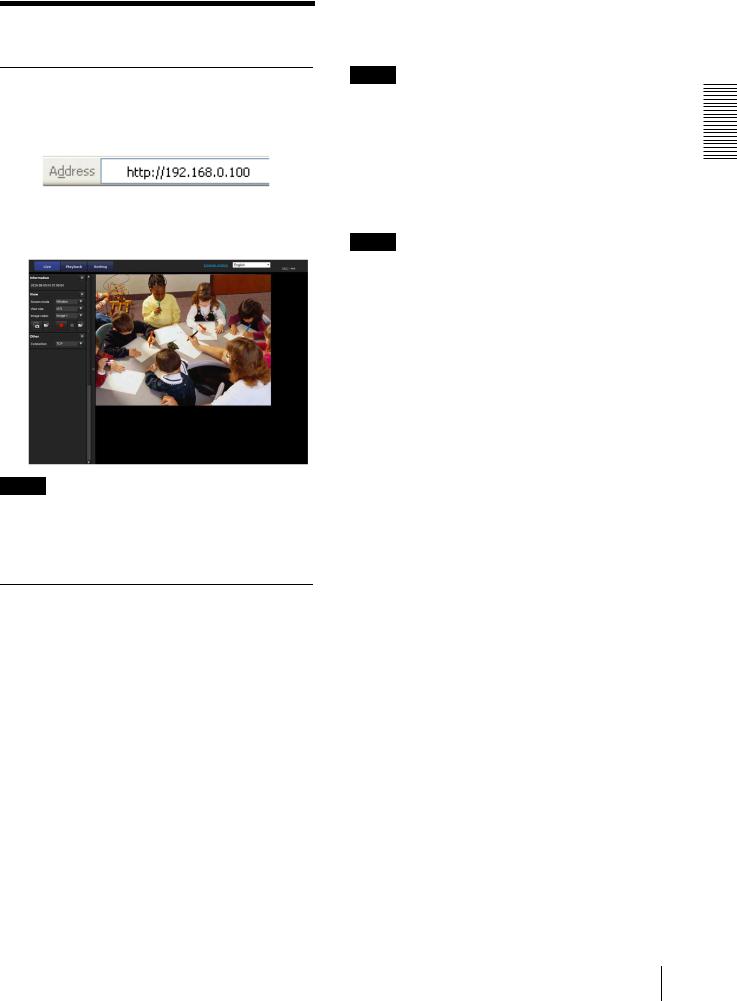
Logging in to System
Logging in as a user
1 Start the Web browser on your computer and type the IP address of the camera you want to monitor.
The live viewer is displayed.
Display sample:
Plug-in free viewer
This viewer enables a browser other than Internet Explorer to display images.
Notes
•If Automatic configuration is enabled in the Local Area Network (LAN) Settings of Internet Explorer, the camera image may not be displayed. In that case, disable Automatic configuration and set the proxy server manually. For the setting of the proxy server, consult your network administrator.
•When you install ActiveX Control, you should be logged in to the computer as the Administrator.
Tips
•Every page of this software is optimized for Internet Explorer in Medium font.
•In case a part of the image cannot fit the display, configure the display setting (magnification percentage) to 100%.
If you use a display with high pixel density, the magnification percentage may be changed automatically.
Camera the Operating
Note
If the live viewer does not start correctly, the security level of the Internet Explorer may be set to higher than Medium. See “To display the viewer correctly” on page 9 and check the security level.
About Viewers
You can use the following viewers.
ActiveX viewer
This viewer can monitor the camera image in any of the JPEG and H.264 video codecs.
Two types of ActiveX viewer are available: Live viewer and Playback viewer.
You must install this viewer when you access the viewer for the first time.
When you display the viewer of the camera for the first time
When you access the network camera using ActiveX viewer for the first time, the Security Warning appears. Click Yes and install ActiveX Control. You can use all the functions of the viewer with ActiveX Control.
Logging in to System 13
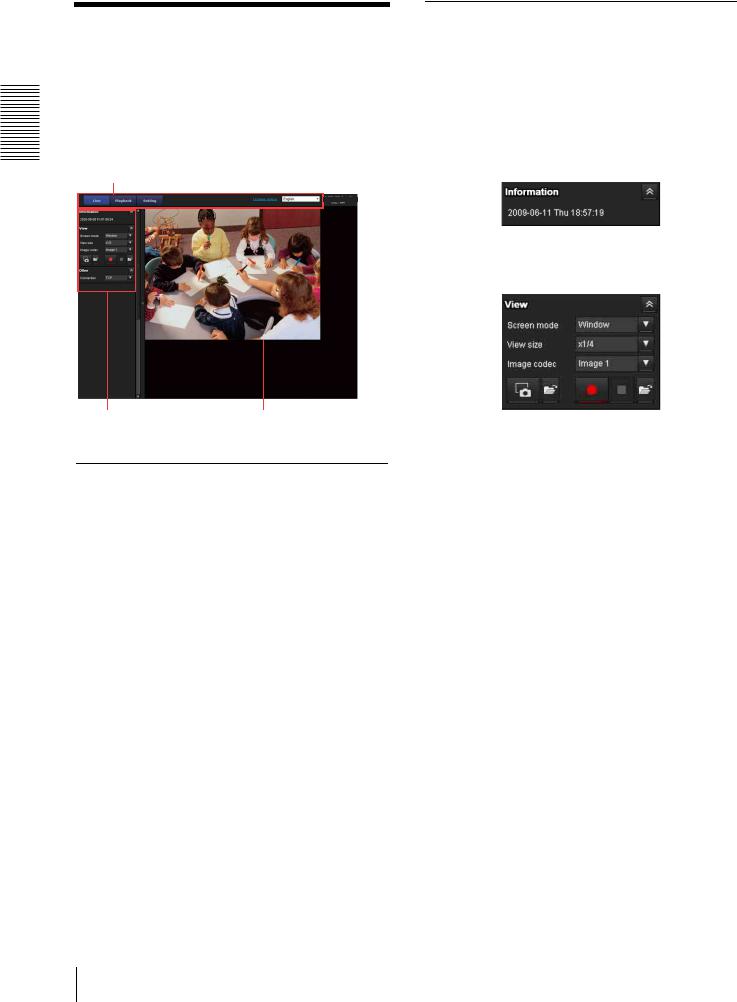
Configuration of Live
Viewer
This section explains the functions of the parts and controls of the live viewer. For a detailed explanation on each part or control, see the specified pages.
Live viewer using ActiveX viewer
CameratheOperating |
Main menu |
|
Control panel |
Monitor image |
section |
section |
Main menu
Live viewer
Displays the ActiveX viewer or the Plug-in free viewer.
Playback viewer
Click to play, save and delete the recorded movie in the memory card. (page 20)
Setting
Click to display the Administrator menu. (page 23) You can operate this function only when logging in as the administrator.
License notice
Displays the software consent agreement, etc.
Language
Set language from pull-down.
Control panel section
You can drag the panels to the monitor screen and configure them.
To return to the control panel, drag the panel and configure the control panel.
Click the  to hide the detail setting menu or click it again to show the menu.
to hide the detail setting menu or click it again to show the menu.
Information panel
Check the date and time here.
View panel
You can change the screen mode, view size of the image, image codec mode and frame rate. Also, still images and movies can be saved (movie saving can also be stopped) from here. Microphone and audio output levels can be adjusted.
Screen mode
Select Window or Full Screen.
View size
Selects the view size to be displayed.
Click View size list box to select the view size.
Select ×1/4 to display images, reduced to 1/4 of the size set in Image size.
Select ×1/2 to display images, reduced to 1/2 of the size set in Image size.
Select ×1 to display images set in Image size (page 32) of the Video / Audio menu or Video menu.
Select Full to display images according to the view size. Select Fit to display images according to the view size, with fixed aspect ratio.
Image codec
Select Image1, Image2 and Image3 of the video codec.
Frame rate
(Displayed only when the camera image is in JPEG.) Selects the frame rate to transmit images.
14 Configuration of Live Viewer
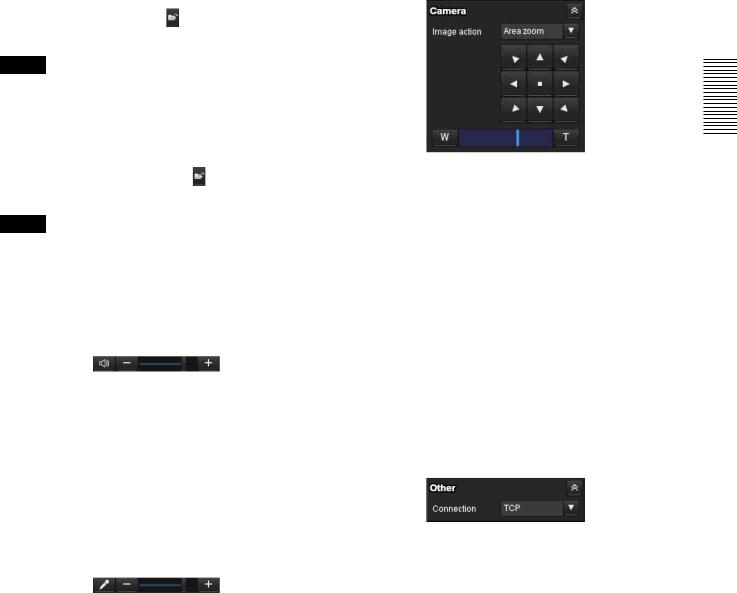
 Capture
Capture
Click to capture a still image shot by the camera and to store it in the computer. Click to open the folder to be saved.
Note
When protection mode (Windows > Control panel > Internet options > Security property) is enabled, still images cannot be captured.
 Run/
Run/ Stop Save Video
Stop Save Video
Runs and stops Save Video. Click |
to open the folder |
to be saved. |
|
Note
When protection mode (Windows > Control panel > Internet options > Security property) is enabled, videos cannot be saved.
Volume
Displays when Enable in the Audio tab of the Video / Audio menu is checked.
Use the slide bar to adjust the volume for sound output level.
When you click  , the icon changes to
, the icon changes to  and the output from the speaker stops. To output sound from the speaker, click
and the output from the speaker stops. To output sound from the speaker, click  again.
again.
Mic volume
Displays when Audio upload (page 33) in the Audio tab of the Video / Audio menu is set to Enable, and a user with audio enabled in the User tab of the Security menu accesses the device.
Use the slide bar to adjust the microphone volume.
When you click  , the icon changes to
, the icon changes to  and the microphone input stops. To input the microphone, click
and the microphone input stops. To input the microphone, click  again.
again.
Camera control panel
This panel allows you to control the camera’s pan/tilt/ home position and zoom (page 17).
Image action
Select the mode of operation from Off, Area zoom and
Vector dragging.
Pan/Tilt control
Click the arrow button the direction in which you want to move the camera. Keep it pressed to move the camera continuously.
To return to the home position, click  .
.
Zoom control
Click  to zoom out, and click
to zoom out, and click  to zoom in. Zooming continues while the button remains pressed.
to zoom in. Zooming continues while the button remains pressed.
Other panel
(The Other panel is displayed in the case of an H.264 image.)
You can switch between TCP and UDP (Unicast/ Multicast).
Each click switches the transmission mode of the video/ audio data between TCP mode, Unicast mode, and Multicast mode (page 19).
Camera the Operating
Configuration of Live Viewer |
15 |
|
|
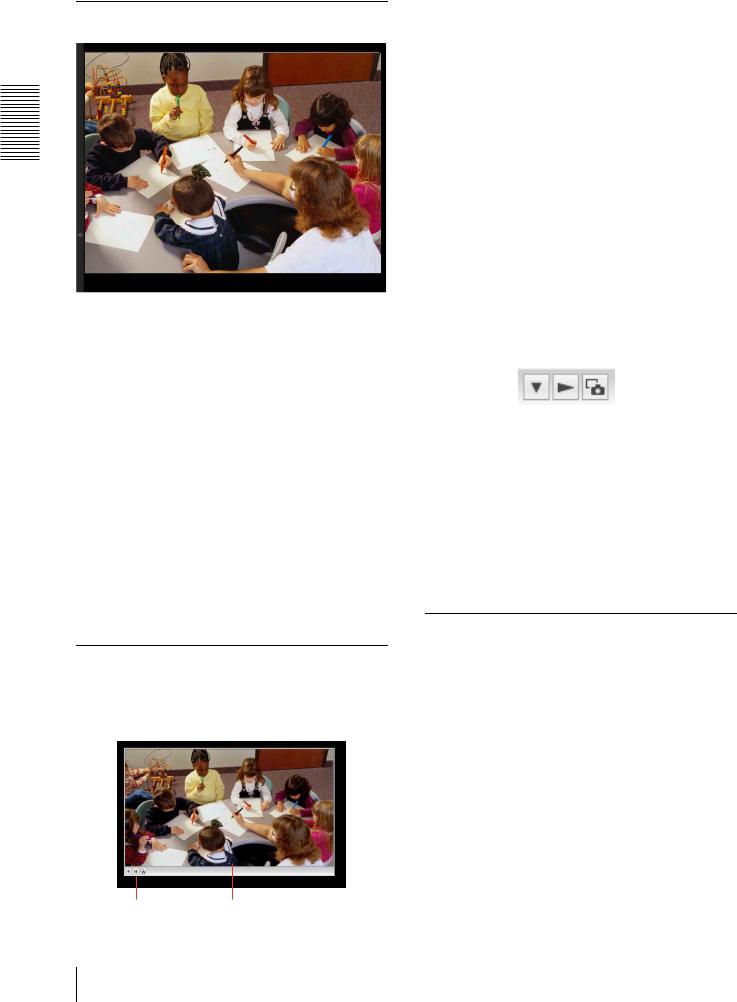
Monitor image
Camera the Operating
The image shot by the camera is shown here. There are two modes for on-screen pan/tilt/zoom
operation using a mouse: Area zoom mode and Vector dragging mode.
In the Area zoom mode, click to adjust the camera direction to the center of the image.
The Area zoom will move the camera in the direction that displays the area selected by the operator and zooms in at the same time. The operator can choose a part of the image to view and zoom in by surrounding an area with a frame by dragging the mouse.
In the Vector dragging mode, the camera moves to the dragged direction. How long you drag the mouse determines the speed. Releasing the button on the mouse after dragging stops the panning or tilting of the camera. You can also use the camera control panel bar to change the camera direction.
The zoom operation using the mouse wheel is available in all modes.
Plug-in free viewer
Live viewer using Plug-in free viewer
Display sample:
Control bar |
Monitor screen |
Monitor screen
There are two modes for on-screen pan/tilt/zoom operation using a mouse: Area zoom mode and Vector dragging mode. A control bar is displayed on the screen. In the Area zoom mode, click to adjust the camera direction to the center of the image.
The Area zoom will move the camera in the direction that displays the area selected by the operator and zooms in at the same time. The operator can choose a part of the image to view and zoom in by surrounding the area with a frame by dragging the mouse.
In the Vector dragging mode, the camera moves to the dragged direction. How long you drag the mouse determines the speed. Releasing the button on the mouse after dragging stops the panning or tilting of the camera. You can also use the tool bar to change the camera direction.
The zoom operation using the mouse wheel is available in all modes.
Control bar
The following operation buttons are available.
 Setting
Setting
You can set the streaming method, image size, frame rate, PTZ operation mode and image codec.
 Streaming start button
Streaming start button
Starts streaming. (Appears while stops streaming.)
 Streaming stop button
Streaming stop button
Stops streaming. (Appears while streaming.)
 Save still image button
Save still image button
Captures still images taken by the camera and saves them to the computer.
Using e-Varifocal and Solid PTZ functions
You can operate the camera by using the e-Varifocal and Solid PTZ functions, which provide panning, tilting and zooming by adjusting the position and zooming ratio from the maximum image size (1280 × 720*, 1280 × 1024**, 1920 × 1080***), without moving the camera.
*1280 × 720: SNC-CX600W/CX600
**1280 × 1024: SNC-VB600/VB600B/VM600/ VM600B/VM601/VM601B/VM602R/EB600/ EB600B/EB602R/EM600/EM601/EM602R
***1920 × 1080: SNC-VB635/VB630/VB632D/ VB640/VB642D/VM630/VM631/VM632R/VM641/ VM642R/EB630/EB630B/EB632R/EB640/EB642R/ EM630/EM631/EM632R/EM641/EM642R/XM637/ XM636/XM632/XM631
16 Configuration of Live Viewer
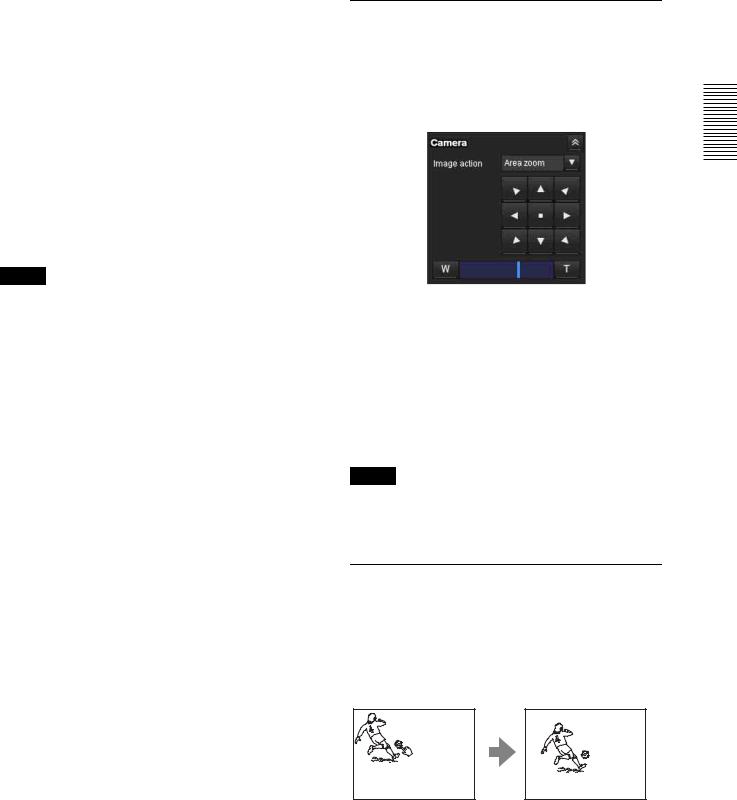
There are three modes of camera operation: Area zoom mode, Vector dragging mode and PTZ Control bar. You can control pan/tilt and zoom in either mode.
The available functions for the camera operation modes vary according to the live viewer display. The available functions are as follows.
|
ActiveX |
Plug-in free viewer |
||
|
|
|
||
|
viewer |
JPEG |
MJPEG |
|
|
|
|||
|
|
|
|
|
Operation from |
a |
– |
– |
|
control panel |
||||
|
|
|
||
|
|
|
|
|
Area zoom |
a |
a |
a |
|
|
|
|
|
|
Vector dragging |
a |
a |
a |
|
|
|
|
|
|
PTZ control bar |
– |
a |
a |
|
|
|
|
|
|
Notes
•Pan/Tilt limitation
The e-Varifocal and Solid PTZ functions control streaming by cropping or reducing a maximum size image.
Thus, the more the camera zooms out, the less area to be panned or tilted, and becomes unavailable at the WIDE end.
•Zoom limitation
An e-Varifocal function adjusts the angle of image in the range with less image quality degradation by limiting the cropped range of the image to the shooting range of equal magnification size. Use the e-Varifocal function by selecting an image size other than the maximum size in the Video codec tab. Zoom limitation is changed depending on the selected image size.
The solid PTZ function enables you to display an area of 1/16 the maximum image size (Aspect ratio: 1:4), when zoomed in at the TELE end. An image cannot be enlarged beyond this.
And the whole area shot in the maximum image size will be displayed if the camera is zoomed out at the WIDE end.
The solid PTZ function’s zoom is performed digitally; therefore, some deterioration in image quality may be observed at the TELE end.
•The Plug-in free viewer display method will be selected automatically.
Controlling via the control panel (Operation common to Area zoom mode and Vector dragging mode)
You can operate the camera direction and zoom by using the control panel for the monitor image currently displayed.
Pan/Tilt control
Click the arrow button in the direction in which you want to move the camera. Keep it pressed to move the camera continuously.
To return to the home position, click  .
.
Zoom control
Click  to zoom out, and click
to zoom out, and click  to zoom in. Zooming continues while the button remains pressed.
to zoom in. Zooming continues while the button remains pressed.
Note
The four edges of the image may be dark depending on the zoom position. This is a phenomenon related to the structure of the camera, and does not cause a problem.
Panning and tilting by clicking the monitor image (Area zoom mode only)
Click on the monitor image, and the camera moves so that the clicked portion is positioned at the center of the display.
Camera the Operating
Configuration of Live Viewer |
17 |
|
|

Camera the Operating
Panning, tilting and zooming by specifying the area (Area zoom mode only)
Click and hold the left button of the mouse on the monitor image, and drag the mouse diagonally to draw a red frame around the portion you want to enlarge. The camera moves so that framed portion is positioned at the center of the display and is zoomed in.
Note
When the specified area is zoomed in, the center may be shifted or some portion of the image may appear out of the monitor image section. In this case, click the point you want to move to the center or click the arrow button on the camera control panel.
Panning and tilting by dragging the screen (Vector dragging mode only)
When you click on the starting point on the image and drag to the end point, the camera pans/tilts in the direction of the arrow from the starting point to the end point. The speed of operation is determined by the length of arrow. Releasing the button on the mouse stops the panning/tilting of the camera.
Using pan/tilt/zoom operations with the displayed control bar (PTZ Control bar only)
Pan/Tilt operations
Click the arrow of the direction you wish to move the camera. Continue pressing on the arrow to keep moving the direction of the camera.
Zoom operation
Click  to zoom out, click
to zoom out, click  to zoom in. The zoom operation continues while you are pressing on the button.
to zoom in. The zoom operation continues while you are pressing on the button.
18 Configuration of Live Viewer

Switching Transmission
Mode
You can change the transmission mode for video/audio data.
This function can be used when the video codec mode is set to H.264 and the ActiveX viewer in the live viewer is used.
Note
The function may not operate correctly if you use personal firewall software or antivirus software on your computer. In that case, disable the software or select the TCP mode.
1 Select TCP, Unicast or Multicast from the
Connection drop-down list in the Other panel.
TCP: This is normally selected.
When TCP is selected, HTTP communication is adopted for video/audio communications. HTTP is the protocol used for reading the usual Web page. In an environment capable of reading Web pages, you can watch or listen to video/audio by selecting the TCP port.
Unicast: When Unicast is selected, RTP (Realtime Transport Protocol) is adopted for video/audio communications. Since RTP is the protocol for running video/audio data, the video/audio playback is smoother than when TCP (HTTP) is selected. If a firewall is installed between the camera and the computer, or depending on the network environment, video/audio may not play back properly when Unicast is selected. In this case, select TCP.
Multicast: This protocol is selectable when Multicast streaming in the Streaming tab of the Video / Audio menu or Video menu is set to Enable. When Multicast is selected as the transmission port, RTP (Real-time Transport Protocol) and UDP multicast techniques are adopted for video/audio transmission. By selecting it, the network transmission load of the camera can be reduced. If a router that does not correspond to a multicast or firewall is installed between the camera and the computer, video/audio may not play back properly. In this case, select TCP or Unicast.
Note
When connecting via a proxy server, neither Unicast nor Multicast can be selected.
Camera the Operating
Switching Transmission Mode |
19 |
|
|

|
Playback viewer |
|||||||
|
Supported models: SNC-VB635/VB630/VB600/ |
|||||||
|
VB600B/VB632D/VB640/VB642D/VM630/VM600/ |
|||||||
|
VM600B/VM631/VM601/VM601B/VM632R/ |
|||||||
|
||||||||
|
||||||||
|
||||||||
|
VM602R/VM641/VM642R/EB640/EB642R/EM641/ |
|||||||
|
||||||||
|
||||||||
|
||||||||
|
EM642R/XM637/XM636/XM632/XM631/CX600W/ |
|||||||
|
||||||||
|
||||||||
|
||||||||
|
CX600 |
|||||||
|
||||||||
|
||||||||
|
||||||||
|
||||||||
|
You can play, save or delete the movies recorded in the |
|||||||
|
||||||||
|
||||||||
|
||||||||
Operating |
memory card. |
|||||||
This function is available only in the following users. |
||||||||
|
||||||||
|
• Administrator |
|||||||
Camera the |
• When Viewer mode is set to Full |
|||||||
|
|
|
|
|
|
|
||
|
|
|
|
|
|
|
||
|
|
|
|
|
|
|
||
|
|
|
|
|
|
|
|
|
|
|
|
|
|
|
|
|
|
|
|
|
|
|
|
|
|
|
Control panel |
Monitor image |
section |
section |
Control panel section
View panel
You can change the screen mode or view size of the image.
Screen mode
Select Window or Full Screen.
View size
Select the view size to be displayed.
Click the View size list box to select the view size. Select ×1/4 to display images, reduced to 1/4 of the size set in Image size.
Select ×1/2 to display images, reduced to 1/2 of the size set in Image size.
Select ×1 to display images set in Image size (page 32) of the Video / Audio menu.
Select Full to display images in full size.
Select Fit to display images in full size with fixed aspect ratio.
Search panel
Specify the search period.
Start
Select the start time for searching.
End
Select the end time for searching.
Maximum search number
You can specify the maximum number of the search results.
Search
Search for recorded movies in the specified period.
Search results list
Displays the search results from the search panel. You can select the movie which you want to play, save or delete.
You can select multiple files for deletion by clicking those movies while pressing the control key.
Range of the search results displayed in the list
Indicates the list of the total search results that is currently displayed.
20 Playback viewer
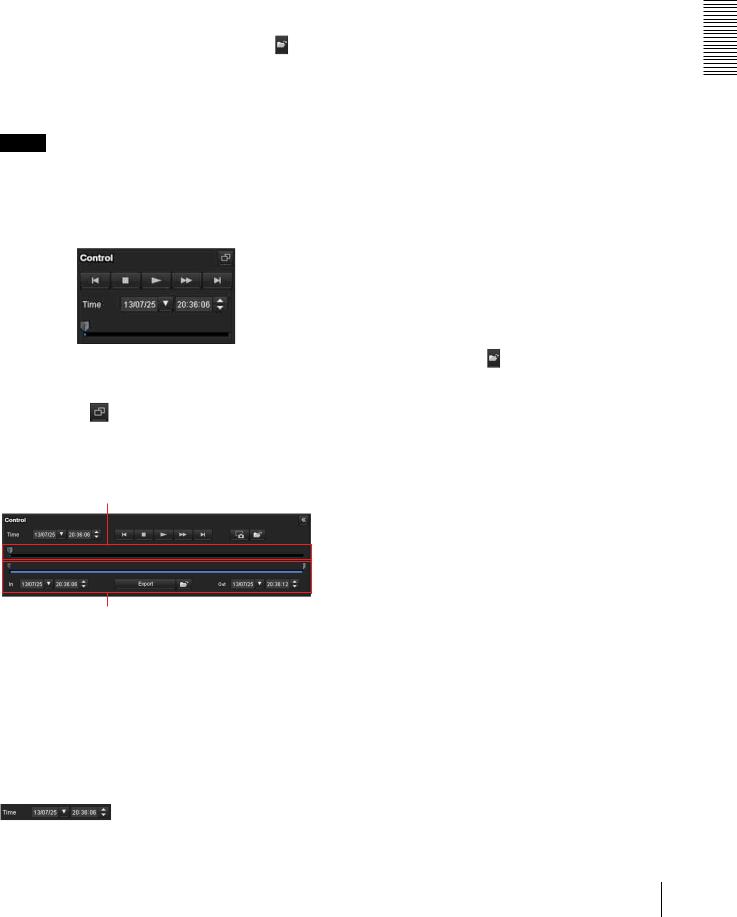
 Go to the next search result
Go to the next search result
Displays the next search results.
 Go to the previous search result
Go to the previous search result
Displays the previous search results.
 Save recorded movie
Save recorded movie
Save the selected movie to your computer. Click to open the folder in which the movie is to be saved.
 Delete recorded movie
Delete recorded movie
Delete the selected movie(s).
Note
Only the administrator can delete movies. Deleted movies cannot be restored.
Control panel (Basic)
You can play, pause, stop, fast forward or jump the selected movie on the search results list. Also you can specify the start position for playback.
If you click the button, the control panel (detail) is displayed.
Control panel (Detail)
Specify the start position for playback
Specify the playback time
You can play, pause, stop, fast forward or jump the selected movie on the search results list. Also you can specify the start position for playback, playback time, save the movie or save the captured still image.
If you click the  button, the control panel (basic) is displayed.
button, the control panel (basic) is displayed.
Specify the start position for playback
Move the start position by dragging the slider.
Time
Specify the recorded date and time from which the movie will start playback.
 Previous record
Previous record
Jump to the previous movie.
 Stop button
Stop button
Click this button to stop a movie playing.
 Play button
Play button
Play the movie.
Click this button to play the movie at the normal speed after pressing the fast forward button.
 Pause button
Pause button
Click this button to pause a movie playing.
 Fast forward
Fast forward
Click this button to fast forward the moving being played.
 Next record
Next record
Jump to the next movie.
 Still image capture
Still image capture
Save the capture of a recorded movie as a still image file to your computer. Click to open the folder in which the movie is to be saved.
Specify the playback time
Specify the start and end position of the movie by moving the slider.
You can save the specified time to your computer.
You can also specify the start time to In and end time to
Out.
 Save selected part of recorded movie
Save selected part of recorded movie
Save the part of movie which is specified by the playback time to your computer. Click  to open the folder in which the movie is to be saved.
to open the folder in which the movie is to be saved.
Camera the Operating
Playback viewer 21

Monitor image
Camera the Operating
Play the selected movie from the search results list.
22 Playback viewer

Administrating the Camera
This section explains how to set the functions of the camera by the Administrator.
For details about monitoring the camera image, see “Operating the Camera” on page 12.
This section explains the basic operations and each option of the Administrator menu.
Note on the display of menu options
The setting menus of this unit will clearly display only the setting options that you can currently select. Grayed out options cannot be selected.
Only supported functions are displayed.
Basic Operations of the
Administrator Menu
You can use the Administrator menu to set all functions to suit the user’s needs.
Click Setting in the viewer to display the Administrator menu.
How to set up the Administrator menu
1 Log in to the homepage to display the viewer. For details, see “Logging in as a user” on page 13.
2 Click Setting on the main menu.
The authentication dialog appears. Enter the user name and password for Administrator. The Administrator menu appears.
The user name “admin” and password “admin” are set at the factory for the Administrator.
For security, be sure to change the password from the factory setting before using the camera. Create a user name and password using half-width characters that do not include “, (comma)”, “#”, “&”, “:” or “(space)”.
3 Click the menu name (example: System) on the left side of the Administrator menu.
The clicked menu appears.
Example: “System” menu
4 Select the required tab above the menu, and set each setting option in the tab.
Example: “Date & time” tab of “System” menu
See page 24 for details of the menu tabs and setting options.
5 After setting, click OK.
The settings you have made become active.
Click Cancel to nullify the set values and return to the previous settings.
Buttons common to every menu
The following buttons are displayed on all the menus.
Click this button to confirm the settings.
Click this button to nullify the set values and return to the previous settings.
General notes on menus
•Input characters (for usernames, for example) in halfwidth characters on a computer. Half-width katakana cannot be used.
•After changing a setting on a menu, wait at least 30 seconds before turning off the power of the camera. If the power is turned off immediately, the new setting may not be stored correctly.
•If the camera settings are changed while watching the live viewer, some settings cannot be restored. To reflect the change on the opening live viewer, click Refresh on the Web browser.
Configuration of the Administrator menu
System
Displays the System menu. (“Configuring the System — System Menu” on page 24)
Video / Audio
Displays the Video / Audio menu for setting the camera image and audio. (“Setting the Camera Image and Audio
— Video / Audio Menu Setting the Camera Image — Video Menu” on page 28)
Camera the Administrating
Basic Operations of the Administrator Menu |
23 |
|
|
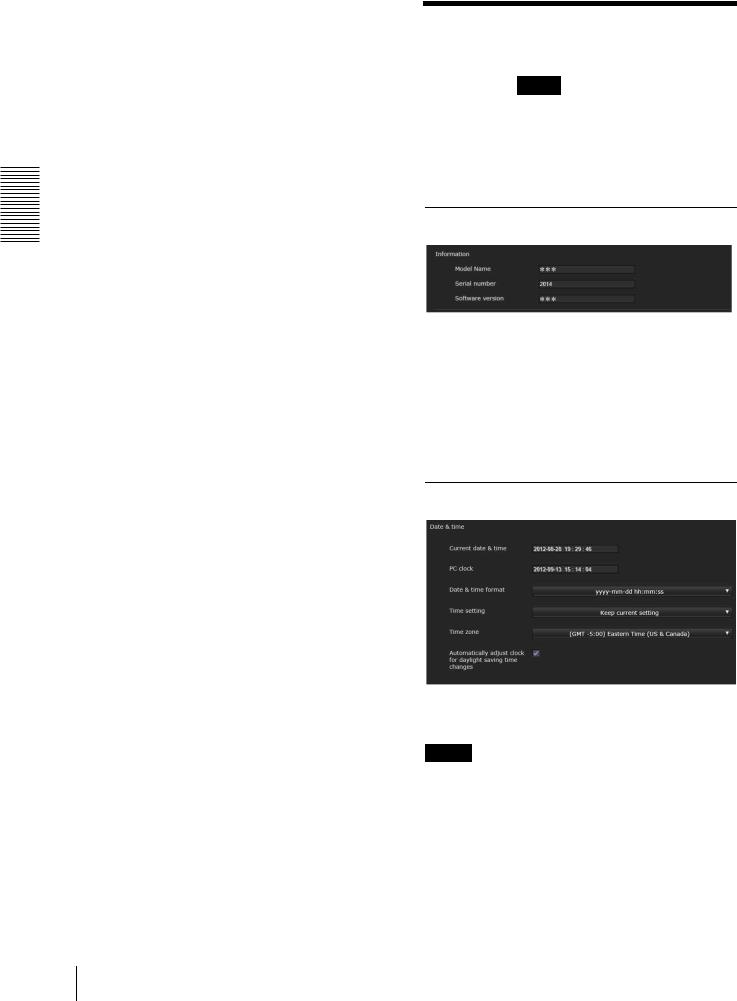
Camera the Administrating
Video
Displays the Video menu for setting the camera image. (“Setting the Camera Image and Audio — Video / Audio Menu Setting the Camera Image — Video Menu” on page 28)
Network
Displays the Network menu for setting the network connection. (“Configuring the Network — Network Menu” on page 38)
Security
Displays the Security menu for setting the login user name and password to specify which computer(s) can connect to the camera. (“Setting the Security — Security Menu” on page 44)
PTZ control
Displays the setting menu for view angle and serial interface. (“Setting the PTZ control — PTZ control Menu” on page 53)
Action input
Displays the setting menu for all built-in detection functions. (“Setting the Sensor input/Camera tampering detection/Motion detection — Action input Menu” on page 54)
Action output
Displays the Action output menu for setting an action of the functions such as e-Mail (SMTP) and Edge Storage. (“Setting the Action output — Action output Menu” on page 63)
Schedule
Displays the Schedule menu for the e-Mail (SMTP) function, Alarm output function, Voice alert function, etc. (“Setting the Schedule — Schedule Menu” on page 72)
Configuring the System
— System Menu
When you click System in the Administrator menu, the System menu appears.
Use this menu to perform the principal settings of the software.
The System menu consists of the following tabs:
Information, Date & time, Installation, Initialize, System log and Access log.
Information Tab
Model Name
The model name of the camera is displayed.
Serial number
The serial number of the camera is displayed.
Software version
The software version of the camera is displayed.
Date & time Tab
Current date & time
Displays the date and time set on the camera.
Note
After you have purchased the camera, be sure to check the date and time of the camera and set as necessary.
PC clock
Displays the date and time set on your computer.
Date & time format
Select the format of date and time to be displayed in the viewer from the drop-down list.
24 Configuring the System — System Menu
